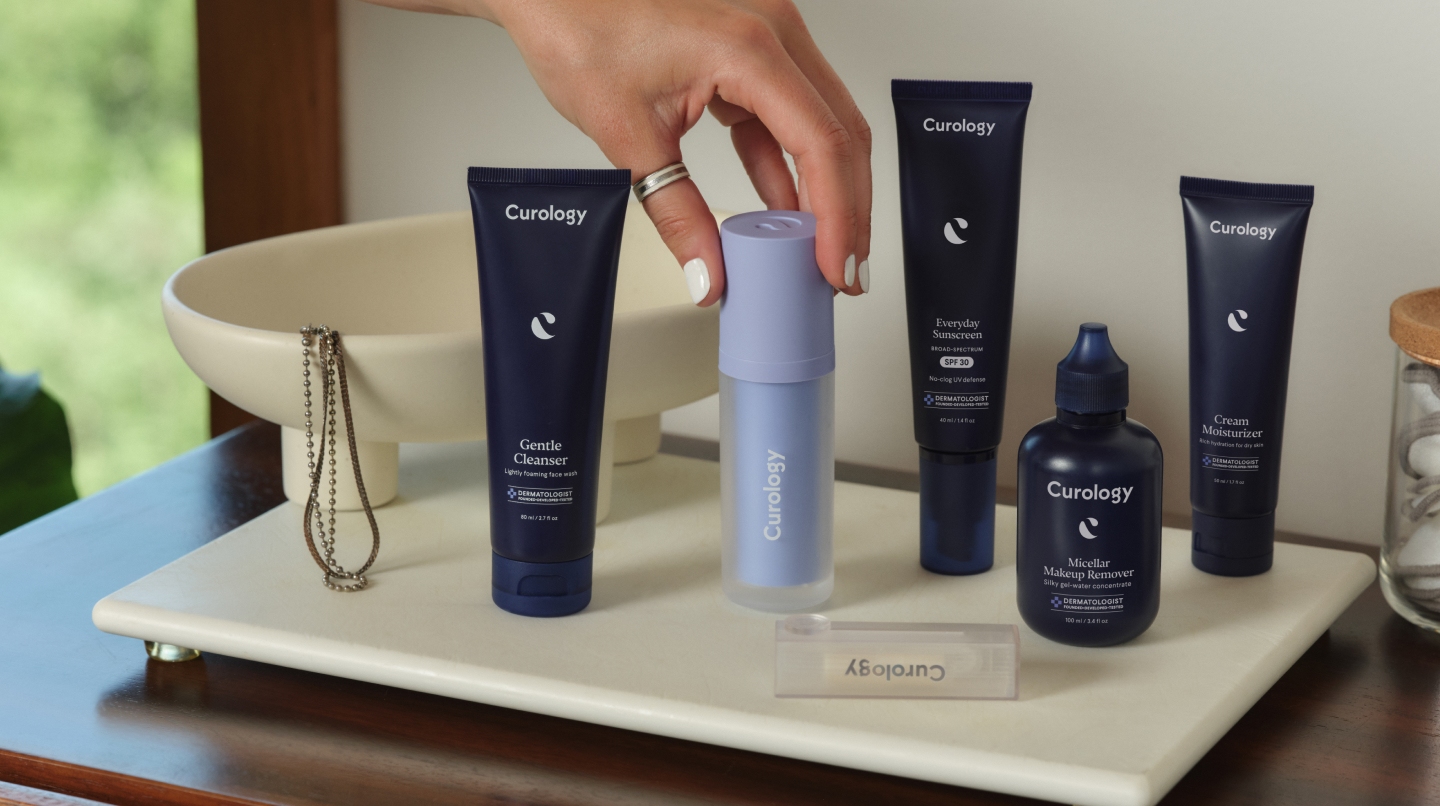How it works:
Share your skin goals and snap selfies
Your dermatology provider prescribes your formula
Apply nightly for happy, healthy skin
How it works:
How it works:
Share your skin goals and snap selfies
Your dermatology provider prescribes your formula
Apply nightly for happy, healthy skin
How it works:
How to treat red spots on your skin
Red spots are a common skin concern, but the good news is that they can be treatable.



Here at Curology, we currently focus on the diagnosis and treatment of acne, rosacea, and anti-aging concerns. We don’t treat many of the conditions mentioned in this article. This article is for information purposes.
Ever looked in the mirror and noticed mysterious new red dots on your skin? If so, you’re not alone—many of us have experienced skin irritation in the form of red bumps at one point or another. Most of the time, they’re no cause for any immediate concern. Still, knowing why they’re there never hurts. The tricky thing about red bumps, however, is that they have many potential causes.
We know having red dots on your skin can feel stressful, uncomfortable, and maybe even a little embarrassing. But step one in easing your worries and boosting your confidence is learning about what can cause red dots to appear and how to treat and help prevent them.
What are these red dots on my skin?
When it comes to skin conditions, red dots are common simply because a wide variety of factors can cause them. Here are just some of the skin conditions that can result in red dots on your skin:
Heat rash
Psoriasis
Post-inflammatory erythema (PIE)
Viral infection or bacterial infection
Allergens
Insect bites
As experts in treating and preventing acne, here we’ll focus on post-inflammatory erythema (aka PIE). But if you notice new red dots on your face and/or body, we recommend speaking with your medical provider to help determine the cause, especially because it can be hard to figure out the cause of red dots on your own.

Post-inflammatory erythema (PIE)
Have you waited for your acne to clear up only to discover that, while your pimples have disappeared, there are still flat red dots on your skin where the breakout occurred? Chances are it's post-inflammatory erythema or PIE. These pink, purple, or red spots on your skin—that aren’t itchy—are left behind by inflammation of the skin, commonly caused by acne breakouts. Not all acne results in PIE, but inflamed and irritated breakouts may leave behind these telltale red dots.
Common causes of PIE include:
Dermatitis
Sunburn
Skin injury
Skin inflammation
Is PIE the same as a rash?
While PIE can resemble a rash, they aren’t one and the same. Rashes are skin irritations that result in inflammation and discoloration. PIE refers to the pinpoint red dots on your skin that remain after skin inflammation has subsided, but superficial damage remains. When skin inflammation—like that caused by some acne—results in the dilation or bursting of small blood vessels called capillaries just under the surface of your skin, you may experience PIE as a consequence of the inflammation.
You’ll be happy to know that PIE isn’t permanent. While it can last anywhere from a few days to months, it will eventually fade and disappear.
How can you treat PIE?
The upside to PIE? Unlike some skin problems—like psoriasis—it isn’t permanent, and it usually goes away on its own. But treating the condition and preventing future occurrences can help you relieve symptoms faster. Here are a few treatment options for these red spots:
If your PIE is caused by inflammatory acne, treat active breakouts and take steps to prevent new breakouts from developing. Skincare products containing benzoyl peroxide, salicylic acid, and retinoids can help.
If your PIE is the result of sunburn, treat the damaged area with a gentle moisturizer or lotion (but don’t apply products on open wounds, such as blisters). Using sun protection is important to help existing PIE fade and prevent new red spots, so always wear sunscreen with SPF—even when it’s cloudy out.
Once your skin has healed from active inflammation, you can use topical products that contain ingredients that may improve uneven skin tone and reduce inflammation on the affected area, like azelaic acid and niacinamide. You can buy these products over the counter at a pharmacy or from your favorite skincare brands (like Curology!).
Like any skin condition, PIE is best treated by a medical professional. A dermatology provider can help pinpoint the cause of your PIE and map out an effective course of treatment. If you’re a Curology member, talk to your dermatology provider for help! Ingredients included in several Curology formulas, such as tretinoin, azelaic acid, and niacinamide can be helpful in treating PIE.
A temporary inconvenience
While the red spots on your skin might be one of your biggest worries today, they’ll fade eventually. And remember, your skin is beautiful as is. There’s no shame in having red spots on your skin—it’s a normal part of life. Don’t let PIE keep you from going out and having fun.
Where Curology comes in
Curology is a custom skincare service founded by dermatologists whose mission is to provide accessible skincare to all. We help take the guesswork out of your skincare routine—licensed dermatology providers work with you to examine your skin, assess your skincare goals, and provide custom treatment options. Currently, we treat skincare concerns related to acne, anti-aging, rosacea, and hyperpigmentation.
Get your personalized skincare routine with Curology
Get your personalized skincare routine with Curology


Becoming a member is easy. Just answer a few questions and snap a couple of selfies to help us get to know your skin. If Curology is right for you, one of our in-house licensed dermatology providers will create a personalized prescription formula to address your unique skin concerns, plus any of our recommended products. The first month is free—just pay $4.95 (plus tax) to cover shipping and handling.*
FAQs
When it comes to skin conditions, red dots are common simply because a wide variety of factors can cause them. Here are just some of the skin conditions that can result in red dots on your skin:
Heat rash
Psoriasis
Post-inflammatory erythema (PIE)
Viral infection or bacterial infection
Allergens
Insect bites
While PIE can resemble a rash, they aren’t one and the same. Rashes are skin irritations that result in inflammation and discoloration. PIE refers to the pinpoint red dots on your skin that remain after skin inflammation has subsided, but superficial damage remains.
The upside to PIE? It isn’t permanent, and it usually goes away on its own. But treating the condition and preventing future occurrences can help you relieve symptoms faster.
If your PIE is caused by inflammatory acne, treat active breakouts and take steps to prevent new breakouts from developing.
If your PIE is the result of sunburn, treat the damaged area with a gentle moisturizer or lotion (but don’t apply products on open wounds, such as blisters).
Once your skin has healed from active inflammation, you can use topical products that contain ingredients that may improve uneven skin tone and reduce inflammation in the affected area, like azelaic acid and niacinamide.
* Subject to consultation. Subscription is required. Trial is 30 days. Results may vary.

Curology Team

Meredith Hartle, DO
Related Articles
How to remove makeup without makeup remover wipesThe complete guide to face cleansers for every skin typeDoes dermaplaning cause acne? Experts explainThe 6 best chemical exfoliators for glowing skinNavigating the world of oil-free moisturizers: Our top 4 picksPopular Articles
Ask Curology: Is my cold breaking me out?Slugging: The dermatologist-approved skincare hack going viral on TikTokTretinoin vs retinol: What’s the difference?How to create a self-care routine that actually sticksYour 2023 skincare horoscopeTry prescription skincare
Get routine essentials

Good skin days ahead
- Breakouts
- Redness
- Fine lines
- Dark spots
- Hair thinning